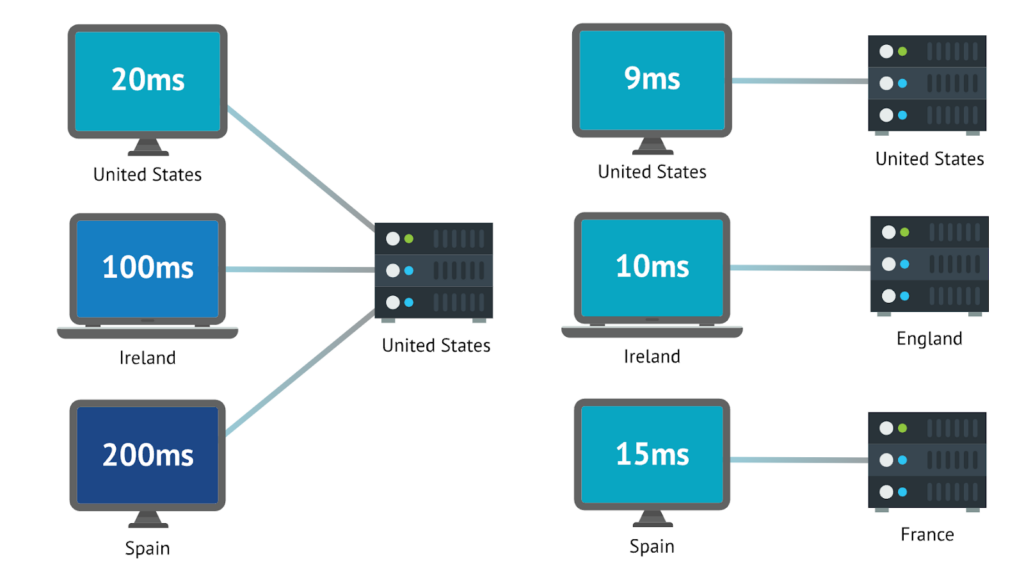In 2024, people just expect their internet connections to be consistent and reliable—and a growing majority believe that it’s on a clear path towards ubiquity. In a recent survey of over 2,500 respondents, researchers at the Pew Research Center’s internet Project reported that the internet will flow through our lives like electricity by 2025.
While fast internet speeds are more accessible than ever before, improving network latency is still a major challenge that organizations around the world are struggling to solve, especially as remote work continues to prove its efficacy. Not only does high latency make it difficult for end-users to stay productive, but it’s also expensive. According to the Rand Group, just one hour of downtime can cost a company upwards of $100,000.
Service providers looking to expand (or remain) into international markets need to understand how latency impacts their businesses. More importantly, you need to know your options for reducing latency. For many organizations, the answer to that question begins and ends with BGP anycast.
What is Network Latency?
Network latency describes the amount of time it takes for data to be delivered from one point to another. Latency is measured in milliseconds, which can also serve as a key metric for various teams across the business.
For example, IT leaders monitor latency to determine the performance and responsiveness of each digital service and application deployed by the company. Software developers who build those services should keep a close eye on latency to understand how quickly a website or application is loading for end users. Even business leaders in sales and product management use latency measurements to understand the areas in which they should improve online applications.
Although the internet often feels invisible to most people, ISPs have installed a complicated web of cables underground that are required for even the worst connections. Since the distance between infrastructure equipment varies, latency will always be a challenge for businesses.
However, it’s critical to minimize latency. Higher latency can negatively impact your website’s performance (including its ranking on search engines) and it increases the likelihood that users leave your site or application completely. According to Akamai, 40% of users are likely to leave a website or application after waiting just 3 seconds for it to load.
What is Latency’s Impact on Network Performance?
Guy Podjarny, former CTO at Akamai, once said that latency is the biggest factor in network constraints of page loading on the Web. This manifests in several ways, many of which dramatically impact the user experience, including:
- Slower response times. High latency slows down the response time (and ultimately the user experience) of critical services that professionals rely on in real time, such as video conferencing and task management applications.
- Lower throughput. Network latency can lead to lower data transfer speeds or throughputs, which is problematic for all workers, especially those who work from home.
- Increased buffering times. Workers who rely on high-quality video conferencing or Voice over internet Protocol (VoIP) may experience extended periods of buffering when network latency is high.
- Limited access to cloud-based data. When a critical cloud-based application suffers from high latency, end-users often fight with slower access to key data and applications they need to stay productive at work.
How can latency negatively impact a business?
In the early days of the internet, latency was considered the price of doing anything online. But as the world becomes increasingly reliant on stable connectivity, most people have little to no patience with an application with high latency. Not surprisingly, their dissatisfaction can have a profoundly negative impact on your business.
Typically, businesses hear a few common complaints from customers due to high latency, including:
- A poor user experience. Not surprisingly, high latency has the most obvious impact on the end-user experience. A few symptoms of network latency are sluggish website loading times and delayed responses when interacting with elements on your site. According to Genesys, one-third of users will ditch a brand completely after a single negative experience.
- Decreased productivity at work. Distributed teams, especially those with workers in different countries, have a difficult time staying productive when their real-time collaboration tools have high latency. As we mentioned earlier in this article, key applications such as video conferencing and file sharing suffer when latency creeps up, which can disrupt even the most productive teams in an organization.
- Loss of revenue: E-commerce businesses rely on low latency across their tech stacks to maintain or improve their conversion rates. According to Nexcess, websites that load in five seconds or more have five times lower conversion rates than sites that load in one second or less.
How can anycast help reduce network latency?
As the cost of downtime continues to increase, service providers are constantly exploring new ways to reduce network latency. Many organizations with a global footprint rely on a network technique called BGP anycast to provide a seamless, reliable, and fast user experience – no matter where the end user is located.
When anycast is added to a business’ infrastructure and network strategy, every incoming request is sent to the highest-performing server via the most efficient route. BGP anycast selects the optimal path by counting the number of hops a requesting packet needs to make, which indicates how many routers are required for data to travel through before reaching its destination. Ultimately, BGP anycast chooses the path with the fewest hops.
Let’s unpack this further. Imagine that you’re running a video streaming platform on an anycast network with locations in Miami, Amsterdam, and Chennai. When a user in Germany requests to stream a video, anycast will evaluate each of the routes available and ultimately stream it from Amsterdam since it has the fewest hops. On the converse, a user in the Southeastern United States (for example, Orlando) making the same request will be served by the Miami server.
In the image below, you’ll see how the lack of distributed infrastructure and servers leads to high latency outside of the United States. On the right-hand side of the image, the anycast network delivers lower latency and better performance to users around the globe because the network is supported by servers in a variety of locations.

These are just a few reasons why anycast is one of the most popular and effective ways to deliver best-in-class user experiences to global audiences. In many cases, the most reliable digital services you use daily are powered by an anycast network.
Conclusion
There is no one simple answer to minimizing latency. It is an ongoing challenge that requires constant attention and optimization to address. End-user expectations will continue to skyrocket, and even just a minute of downtime could damage your company’s reputation and revenues. Without the infrastructure to support increasingly sophisticated digital services, you’re likely to fall behind the competition.
Deploying an anycast solution can help you build more resilient and reliable websites and services that delight your customers, no matter where in the world they are. While this might sound like a huge undertaking, you can reduce latency and deliver best-in-class user experiences with a partner like NetActuate. Ready to talk to an engineer about deploying your latency-optimized global anycast solution? Schedule a call today.
